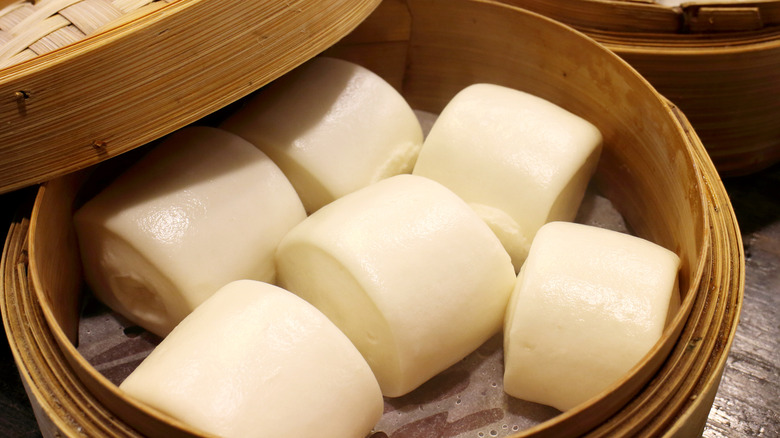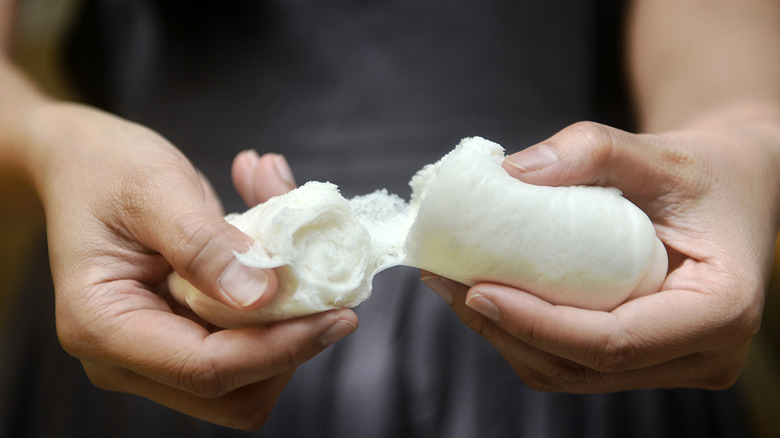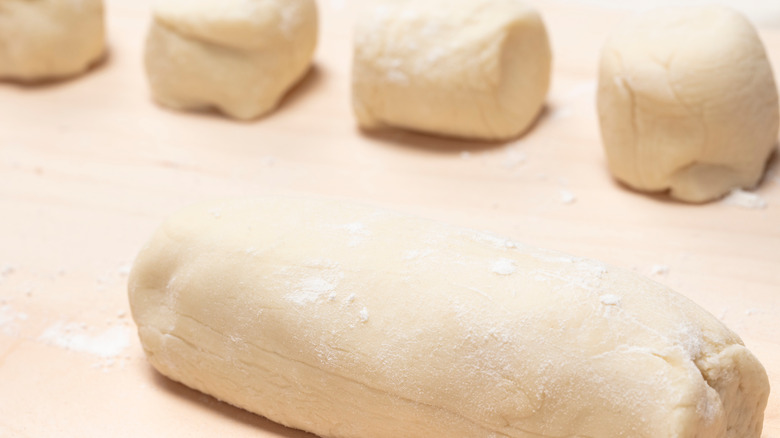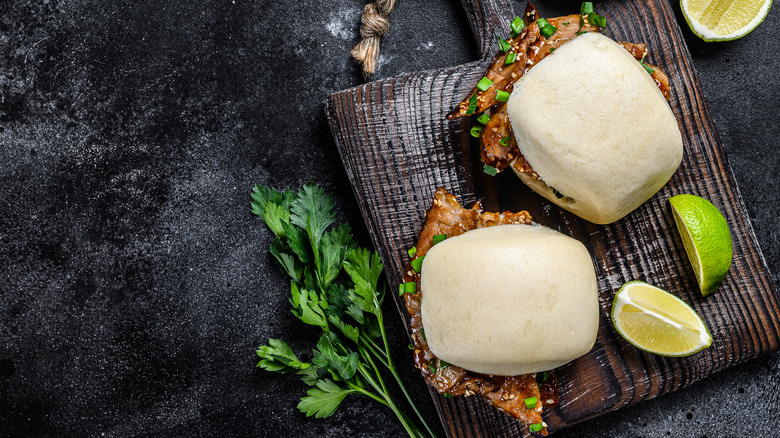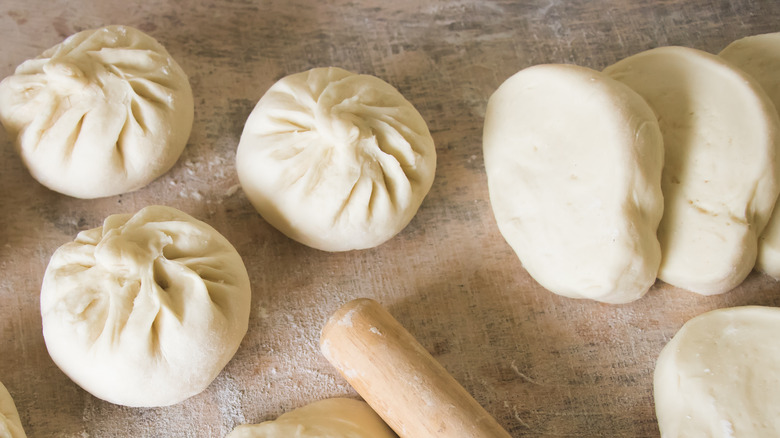What Is Mantou And How Do You Use It?
It may not be as old as the world's oldest bread, which archaeologists think might have been produced 14,400 years ago by dwellers in north-eastern Jordan (via British Baker), but China's humble mantou has a dramatic back story too.
Baking History says the bread might have first appeared as early as the Zhou Dynasty — which lasted from 1046 to 771 BC and has links to one of the greatest war strategists of that time. Legend has it that the mythical general Zhuge Liang was involved in an operation that required him to cross a stormy river, and in order to calm the waters, he needed to sacrifice the heads of 50 "barbarians." In order to fulfill the quota without killing anyone, the crafty general decided to slaughter livestock and to stuff that meat into pieces of dough that were then shaped into heads. The operation turned out to be a success, and the breads were named "barbarian's head" or mantou.
Today, mantou can be found across Asia, but are favored in Northern China, where wheat can be found commonly than rice. They are also not as widely available — or as immediately recognizable — as baozi, which are buns filled with meats, seafood, or vegetables that are enjoyed as a street snack.
What is mantou made of?
Classic mantou is simple, with a plain-ness to its taste that borders on the bland, which is not surprising, considering that it is made of yeast, flour, salt, water, and a bit of sugar to help the yeast along, according to China Sichuan Food. Some recipes also call for the addition of oil or milk. More creative chefs are also choosing to modernize the traditional steamed bread, so it's easy to find mantou which have the addition of everything from pumpkin, beet, matcha, and cocoa powder (via Food52) to taro, nuts, cheese, and dried fruit (via Mindy Makes).
Depending on its size and whether there is any milk or oil (or whether it's fried up to become a mouthwatering dessert), classic mantou can be a low-calorie addition to your meal. It packs just 54 calories, 0.6 grams of fat, no cholesterol, 10.4 grams of carbs, and 1.6 grams of protein (via Cookist).
How is mantou made?
The thought of making mantou might look daunting to those who have never attempted them before — but think of all the people who have been turning them out for as long as mixing flour, a rising agent, and water was a thing.
Red House Spice says the type of flour you use to make your mantou will determine its texture. Medium- to low-gluten flour or all-purpose flour will give you a decent mantou. Cake flour, which has eight to nine grams of protein, will result in a fluffier mantou. However, stay away from self-raising cake flour, which comes with its own raising agent.
Red House Spice and China Sichuan Food both agree that the secret to good mantou lies in the kneading, and that its dough should be well kneaded after the first and second proofing. (China Sichuan Food even suggests that dough is best proofed at 82 F.) Once your mantou is ready to be steamed, make sure you start with cold water. Depending on the kind of steamer you are using (metal or bamboo), the flame can either be kept on high or lowered once the water starts to boil, and left to steam for about 25 minutes. Baos are best consumed hot — and because they harden quickly, they can only be kept for up the three days in a refrigerator, or frozen for up to a month.
How do you use mantou?
Mantou is essentially a blank canvas — something you can use to create or consume other dishes with. It can be eaten plain as a side, with soy milk. Like a crusty, trusty French baguette, mantou can be used as the carrier carb that absorbs mouthwatering sauces. And like a Scotch bap or a burger bun, it can be used as the base for a delectable sandwich (via EatBook) — think the gua bao or pork belly bun, which could well be Taiwan's second most popular food export after bubble tea, per Michelin.
For a truly indulgent treat, smaller pieces of mantou can be deep-fried until they are golden, patted dry on paper towels, and then served with a simple dip made with nothing but condensed milk poured into a dish. China Sichuan Food recommends making (or tracking down) bite-sized pieces of mantou, then deep-frying them in oil (like you would a donut). Deep-fried and steamed mantou can be served beside each other for sweet a "gold and silver" themed treat.
What is the difference between a mantou and bao?
Nearly everyone who has ever grown up with baos (also known as baozi — per China Sichuan Food) and has unwittingly purchased mantou, will understand the crushing disappointment of tearing into one and expecting some kind of filling, only to discover that mantous are, for the most part, a "what-you-see-is-what-you-get" kind of dish (via International Jing Kids).
You might want to think of a bao as an Asian-style calzone — a filled soft, steamed, fluffy bread stuffed with a sweet or savory filling, per The Washington Post. One popular steamed bao incarnation, according to All Recipes, is the Cantonese char siu bao, which has a bright red, slightly sweet pork filling. Baos can also be filled with meat and leeks or cabbage and then fried to make the Shanghai-style sheng jian bao (via Omnivores Cookbook). They can also be stuffed with seasoned pork and a hard-boiled egg to make the Singaporean "big pau," or with pork asado and a meat filling, which combines pork, chicken, beef, shrimp, or salted eggs to make the Filipino siopao.
